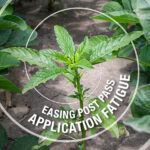Soybean Aphids: Tiny Pests with a Big Impact
Frequent scouting and powerful insecticides are critical when it comes to controlling soybean aphids as they play their part in the overall pest spectrum.

While soybean aphids haven’t been much of a problem over the last few years, they do have the potential to be harmful — particularly in soybean fields with pressure from other insects. Soybean aphids are a unique and challenging insect, especially when you are trying to eliminate them from your soybean fields. These adaptive, invasive insects only reach 1/16 inch in length. Yet, what they lack in size is made up for in quantity.
Scouting for Soybean Aphids
In the summer, soybean aphid populations boom. With high birth rates and short generation times, populations can double every two to three days when conditions are right. Aphids in overcrowded fields can produce winged forms that easily spread to neighboring fields. Depending on the temperature, growers can expect up to 18 generations of soybean aphids from May to August.
You’ll know you’re dealing with soybean aphids when you spot small, pear-shaped yellow insects with black cornicles near the rear. These pests are typically found on the underside of soybean leaves. As aphid pressure increases, white flakes become more apparent on the surface of leaves. These are the cast skins of molting nymphs.
Another reliable indicator of soybean aphids is the presence of natural predators like lady beetles and minute pirate bugs. Often, ants will be easily visible on the stems of plants affected by soybean aphids.
Why Worry About Soybean Aphids?
Due to their high reproductive potential, a few soybean aphids can quickly become a serious threat. Feeding damage can weaken plants and make them more susceptible to other stressors like drought and disease. Soybean aphids extract plant juices through their needle-like mouths and excrete honeydew, a sugary waste product. Sooty mold can develop on the honeydew excretions and cause yield losses of up to 40%.
Aphids pose the greatest threat to soybean yield during the R1-R4 stages. When contemplating treatment, consider the growth stage of the plants, other stressors and natural predators. Treatment may not be necessary if plants are in later growth stages, if stressors are low or if there are many natural predators in the fields.
The University of Minnesota Extension recommends scouting and counting aphids throughout the growing season. If the average number of aphids on each plant exceeds 250, this means that the economic threshold is reached and an insecticide application is needed to protect your yields from damage. This threshold is considered the tipping point because insecticide applications at lower pressure may not pay for the cost of application.
If the economic threshold is reached, effective insecticides like Endigo® ZCX are necessary to prevent economic injury. Endigo ZCX contains two complementary modes of action to protect yields from soybean aphids and other insect pests. For more information about the economic threshold and solutions for your soybeans, contact your local Syngenta representative.
2 Min Read
- Populations of soybean aphids can double in size every two to three days under the right conditions.
- The economic threshold of 250 soybean aphids per plant helps growers make informed decisions about insecticide applications.
- Effective insecticides like Endigo® ZCX can help manage these pests and maximize yield potential.
More Articles About Field Insights
RECOMMENDED FOR YOU
2 Min Read























